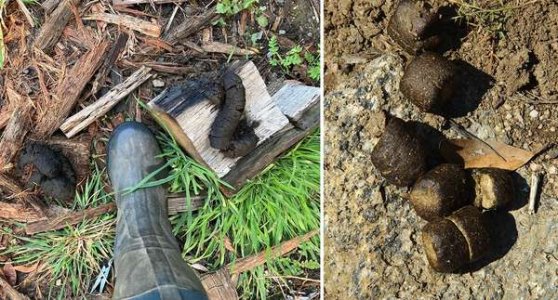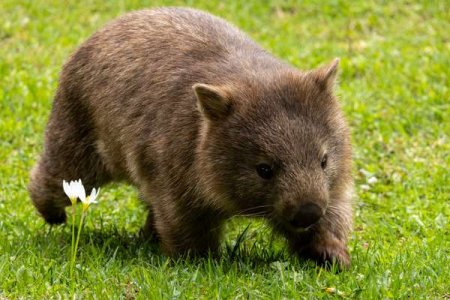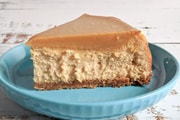‘Almost human’: Woman’s shock find on lawn after moving to remote Tassie farm
By
Ash.S
- Replies 7
When Paddy Zakaria decided to leave the hustle and bustle of Australia's mainland for the serene isolation of a remote Tasmanian farm, she anticipated a life filled with the tranquil sounds of nature and the sight of unfamiliar wildlife. What she didn't expect was to be greeted by a series of mysterious and massive droppings on her new front lawn, droppings so large that they seemed 'almost human'.
The Seniors Discount Club is no stranger to the tales of Australians encountering the unexpected, but Paddy's story is particularly intriguing. The droppings were so large that Paddy couldn't help but capture the evidence on camera, placing her gumboot beside them for scale. The images she took show the sheer size of these deposits, which she described as being 'huge' and 'massive', with one measuring a good 24cm if it were to be straightened out.
Speculation and theories among 500 respondents
Paddy's new home on the Tasman Peninsula, a place teeming with wildlife, seemed to have become a haven for local fauna while the house stood vacant – ‘all the wildlife moved in’, she said. The droppings were so prominent that Paddy shared photos with the Victorian Field Naturalists online forum, sparking a flurry of speculation among nearly 500 respondents. Theories ranged from the logical to the legendary, with suggestions including wombats, wallabies, Tasmanian devils, dogs, and even the mythical yowie—a creature of Indigenous stories and early Australian folklore.
The debate was intense, as many forum members were quick to dismiss the possibility of a wombat due to the common belief that wombats produce cube-shaped droppings. This belief, however, was about to be debunked.
Paddy's past experiences with human littering in the Otways, near Victoria's Great Ocean Road, had made her all too familiar with the unpleasant sight of human waste. Tourists, unable to find facilities, would often leave behind a mess near her property. But upon closer inspection of the Tasmanian droppings, Paddy could tell that these were not left by humans; the fibrous, plant-based content was a clear giveaway.
Expert biologist consulted among growing mystery
To solve the mystery, Yahoo consulted biologist Nick Mooney, an expert in Tasmania's unique ecology. Mooney's expertise led to a swift conclusion: the droppings were indeed from a wombat, and he took the opportunity to bust the myth that wombat droppings are always cube-shaped. He explained that the cubic shape is typically associated with territorial markings, designed to stay atop objects and avoid being destroyed by dung beetles. Wombats, like many creatures, can produce a variety of shapes depending on their diet and health.
Paddy's discovery is a testament to the fascinating and sometimes bewildering encounters one can have when living close to nature. It's a reminder of the diverse and peculiar wildlife that calls Australia home, and the constant learning curve that comes with moving to a new environment.
For our members who have made similar tree-changes or are considering a move to the countryside, Paddy's story is a humorous and educational anecdote about the surprises that await in the great Australian landscape. Saying that, mysterious poo-petrators are not unique to the great Aussie wilderness. Have you had any unusual wildlife encounters since moving to a more remote area? Share your stories with us in the comments below, and let's celebrate the weird and wonderful aspects of Australia's environment together!

The Seniors Discount Club is no stranger to the tales of Australians encountering the unexpected, but Paddy's story is particularly intriguing. The droppings were so large that Paddy couldn't help but capture the evidence on camera, placing her gumboot beside them for scale. The images she took show the sheer size of these deposits, which she described as being 'huge' and 'massive', with one measuring a good 24cm if it were to be straightened out.
Speculation and theories among 500 respondents
Paddy's new home on the Tasman Peninsula, a place teeming with wildlife, seemed to have become a haven for local fauna while the house stood vacant – ‘all the wildlife moved in’, she said. The droppings were so prominent that Paddy shared photos with the Victorian Field Naturalists online forum, sparking a flurry of speculation among nearly 500 respondents. Theories ranged from the logical to the legendary, with suggestions including wombats, wallabies, Tasmanian devils, dogs, and even the mythical yowie—a creature of Indigenous stories and early Australian folklore.
The debate was intense, as many forum members were quick to dismiss the possibility of a wombat due to the common belief that wombats produce cube-shaped droppings. This belief, however, was about to be debunked.
Paddy's past experiences with human littering in the Otways, near Victoria's Great Ocean Road, had made her all too familiar with the unpleasant sight of human waste. Tourists, unable to find facilities, would often leave behind a mess near her property. But upon closer inspection of the Tasmanian droppings, Paddy could tell that these were not left by humans; the fibrous, plant-based content was a clear giveaway.
Expert biologist consulted among growing mystery
To solve the mystery, Yahoo consulted biologist Nick Mooney, an expert in Tasmania's unique ecology. Mooney's expertise led to a swift conclusion: the droppings were indeed from a wombat, and he took the opportunity to bust the myth that wombat droppings are always cube-shaped. He explained that the cubic shape is typically associated with territorial markings, designed to stay atop objects and avoid being destroyed by dung beetles. Wombats, like many creatures, can produce a variety of shapes depending on their diet and health.
Paddy's discovery is a testament to the fascinating and sometimes bewildering encounters one can have when living close to nature. It's a reminder of the diverse and peculiar wildlife that calls Australia home, and the constant learning curve that comes with moving to a new environment.
For our members who have made similar tree-changes or are considering a move to the countryside, Paddy's story is a humorous and educational anecdote about the surprises that await in the great Australian landscape. Saying that, mysterious poo-petrators are not unique to the great Aussie wilderness. Have you had any unusual wildlife encounters since moving to a more remote area? Share your stories with us in the comments below, and let's celebrate the weird and wonderful aspects of Australia's environment together!
Key Takeaways
- Paddy Zakaria moved to a remote farm on the Tasman Peninsula and found massive, 'almost human' poos on her lawn.
- The mystery poos prompted a flurry of speculation on an online forum, with suggestions ranging from wombats to yowies.
- Expert biologist Nick Mooney confirmed that wombats, not humans, were the likely culprits, debunking the myth that wombat poo is always cube-shaped.
- The animal that left the poos had a plant-based fibrous diet, as determined by Paddy's inspection and Nick Mooney's expertise.









